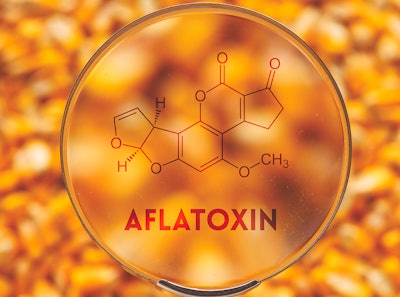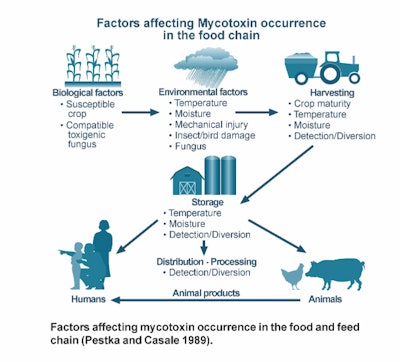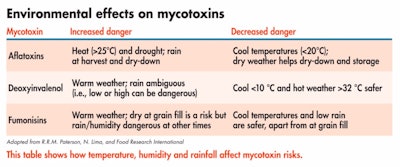
Climate change emerges as a critical issue ensuring food and feed safety
Mycotoxins are toxic compounds that are naturally produced by different types of fungi. When temperature and moisture are conducive, these fungi proliferate and may produce mycotoxins. Mycotoxins enter the food chain as a result of fungal infection of crops before or after harvest and during storage. They are found in raw materials, including cereals, soybeans, vegetable oils and silages.
The presence of mycotoxins in food and feed may cause adverse health effects in humans and animals, ranging from gastrointestinal and kidney disorders to immune deficiency and cancer. The effects on livestock production have been long discussed, impacting growth, mortality, milk and egg production, fertility, gut health and susceptibility to disease.
Exposure to mycotoxins can happen by eating contaminated feed, bedding material or other environmental exposure. The most common mycotoxins that pose a concern to health include aflatoxins, ochratoxin A and Fusarium toxins, such as deoxynivalenol.
Since temperature and humidity are important parameters for fungal growth, climate change is anticipated to impact the presence of mycotoxins.
 Factors affecting mycotoxin occurrence in the food chain (Courtesy Council for Agricultural Science and Technology, CAST)
Factors affecting mycotoxin occurrence in the food chain (Courtesy Council for Agricultural Science and Technology, CAST)Climate change
Climatic conditions, including temperature, rainfall, carbon dioxide level and humidity, affect fungal behavior and mycotoxin production. In general, warmer and wetter weather leads to more mold growth and, hence, greater mycotoxin production. Therefore, if the temperature increases in cool or temperate climates, those countries may become more liable to aflatoxins.
Tropical countries may become too inhospitable for conventional fungal growth and mycotoxin production. Currently cold regions may become liable to temperate problems concerning ochratoxin A, patulin and Fusarium toxins, e.g. deoxynivalenol.
EU predictions
The European Food Standards Agency (EFSA) has looked at how climate forecasts may affect mycotoxin occurrences across Europe. They modeled 2 degrees Celsius and 5 degrees Celsius increases in global temperatures — proposed by the Intergovernmental Panel on Climate Change. With a two-degree increase, they stated that there was a high risk of maize contaminating aflatoxin levels above EU regulatory limits, but aflatoxins would be very low in wheat and absent in rice.
The predictions also showed a reduction in season length and an advance in flowering and harvest dates for all the crops considered. This could allow an enlargement of the crop growing areas towards the north of the EU, mainly for corn and rice, because earlier ripening would then be possible in these areas.
However, in the 5-degree temperature increase, levels of aflatoxin contamination are predicted to be lower, but risks were expected in a wider area, expanding towards northern EU countries.
 This table shows how temperature, humidity and rainfall affect mycotoxin risks.
This table shows how temperature, humidity and rainfall affect mycotoxin risks.Adapting molds
As with all organisms, mold will adapt to changing conditions in order to increase their chances of survival. The table shows how temperature, humidity and rainfall affect mycotoxin risks. Slightly elevated carbon dioxide concentrations — in conjunction with temperature and water availability — may also stimulate growth of some mycotoxigenic species, especially under water stress.
Warmer weather, heat waves, greater precipitation and drought will have various impacts, depending on which regions of the world and mycotoxin systems are considered. Climatic conditions post-harvest will also affect mycotoxin levels, if drying is not effective or if crops are stored in warm, humid conditions.
Aflatoxin is considered to be the riskiest mycotoxin as it is the most toxic and is the focus of much regulation in terms of human food as well as livestock feed. Aflatoxins are mycotoxins produced by two species of Aspergillus, a fungus found especially in areas with hot and humid climates. As such, they are generally found in crops grown closer to the equator, but as the earth warms, they will be found in regions further from it.
Different fungi tend to dominate others dependent on climatic conditions, resulting in changes in mycotoxin threat levels. However, aflatoxin will not be supplanted by ochratoxin in corn and wheat; by deoxynivalenol in corn and wheat; or by fumonisins in corn, where aflatoxin also occurs.
Quality control
As well as looking at changes in the region where the feed is produced, it is essential to look at the origin of raw material — to see if their risk factors have changed.
It is also possible to learn from areas where changes have already occurred as to what might happen in the future, adapting measures accordingly for mycotoxin monitoring, soil management and plant health plans. It is important to be aware of the changes that are likely to happen in the future to protect animal health and performance. Mycotoxin testing protocols should be expanded, and prevention strategies updated accordingly.
Climatic changes are an evolution, which makes them hard to plan for. Therefore, management strategies should be continually rebalanced by feed producers, with the onus on regulatory bodies to preempt and react to changes in mycotoxin risks.
In light of the threat of mycotoxins on animals, it may be wise to test for a wider range of mycotoxins. Rather than basing decisions on what has been found in the past — look to the future of what may be developing. Use information from wider industry surveys to see what others are finding — in what and where — to make sure testing protocols are up to date. Issues currently facing feed producers in India, South East Asia, China or the Middle East may one day be seen in Europe and North America.
Moving with the times
Research has concluded that, in general, there will be more mycotoxins as the effects of climate change increase. There is likely to be an increase in “high-temperature fungi and mycotoxins,” such as aflatoxin — compared to deoxynivalenol. And as sub-tropical regions become tropical — there will be associated changes in mycotoxin contamination patterns. Climate change will affect mycotoxin contamination of crops in different regions and, with that, there will be risks to animal production. The industry may also need to re-evaluate the risks to each species and life stage.
Nature will adapt to a changing climate faster than we can. Although plant breeders are working hard on plant resistance, if the molds are adapting to climatic changes, the benefits of new cultivars may be worthless by the time they come to market.
Changes to the types of crops grown in different regions, themselves due to climate change, will also affect the pattern of mycotoxin contamination. Although predictions are useful, it will be impossible to stay ahead in this situation. Instead, feed producers need to adapt to changes by having a robust monitoring program and effective, but flexible control procedures in place.















